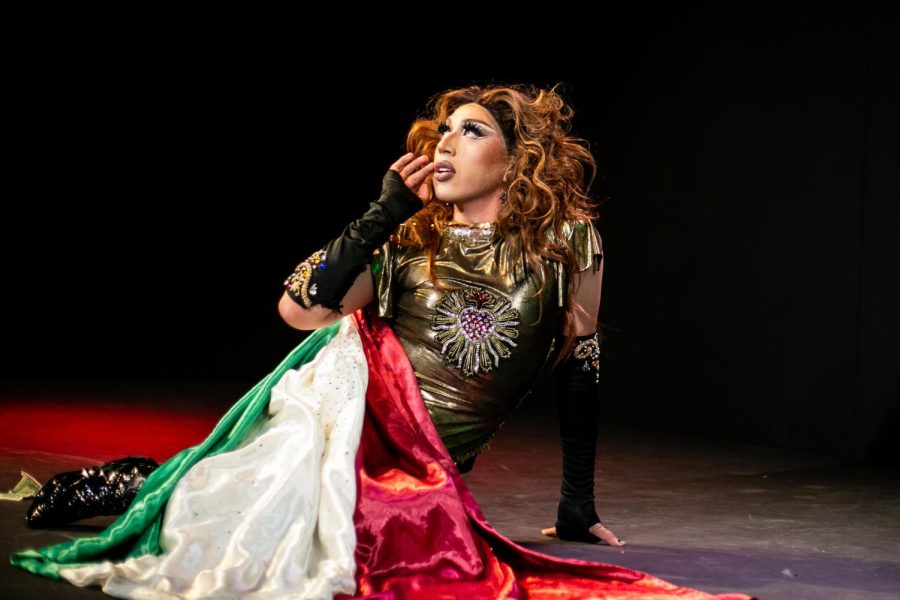Students come to college not only to learn but to find out who they are. For some, they happen to discover that they’re drag queens.
“Once the song started playing, something in me just clicked,” said San Diego State University senior Juan Barcenas, also known as “Lady Blanca.” “I lost my fear and just went into performer mode. Suddenly, I was like, is the song already over? It was so easy. Drag came to me in the moment.”
SDSU’s thriving drag community has a host of new and experienced drag queens, many of whom started their career in drag right on campus.
“One of the first drag shows that I ever saw was here at SDSU. I remember seeing them and feeling so happy. I was happy to be seeing the queer culture and experiencing queer culture in a way I never had before. Once I saw Amber St. James and the other drag queens perform, I felt inspired,” Lady Blanca said.
That first moment resonates with many in the drag community. Whether it is the first step onstage, the swipe of lipstick or the first time they saw themselves in the mirror in full “beat” makeup, drag represents unapologetic self-expression.
“It wasn’t until probably 2020 that I started considering drag,” said senior Soluna Wells (known as “Chikavara).“I was learning a lot about queer history, and the way that drag has always been subversive to mainstream culture. I really wanted a way to express myself.”
Amber St. James, a graduate student, is one of the leading drag queens on campus. St. James is known for their advocacy for change through activism and expressive performances.
“My philosophy is to be authentic and true to who I am and let that shine through in my drag,” St. James said.
Drag performers form bonds with their peers, uniting in a form of chosen family they call a “haus.” Drag mothers and daughters of a haus do much more than hair and makeup — each is a family that expresses their creativity in unique styles. St. James is the founder and drag mother of her own house, the “Haus of St James.”
St. James’ eyes lit up when discussing her drag family and the community that comes from leading a haus.
“For me, as the mother of a drag family, it was always about having that connection,” St. James said. “I really wanted (my drag family) to be a support and a community, not just ‘Oh, we’re just a bunch of drag queens.’ We’re really a chosen family.”
The sense of togetherness and support can be seen and felt. Drag queens express support while their peers perform and behind the scenes help with each other’s makeup. It’s lively and fun, but also an authentic place to grow, according to Lady Blanca.
“Over the last two years that I’ve been part of the St. James family, just seeing them in their element has been really inspiring to me and my art,” Lady Blanca said. “Unknowingly, I’ve taken pieces of their material and made it my own.”
Drag has a national reputation for its dramatic performances but for SDSU’s student performers, it’s much more than entertainment.
“Society sees it as ‘It’s a bunch of men in dresses.’ Girl, it’s never been that,” St. James said. “When you look at the history, drag has always been intertwined with activism. (For example) look at the Stonewall Riots and Marsha P. Johnson… that’s something I always found so much beauty and pride in. I want to shine a light on that.”
Drag, according to these queens, goes beyond makeup and humor. No drag performer is the same — drag is a way for individuals to express their identity, art and social activism.
“Drag allows creativity in the sense that it is a personal art form. Everyone approaches drag differently,” Chikavara said. “That’s what I love about it. For me, drag allows me to be myself because growing up, I wasn’t really able to experiment.”
As Chikavara expressed, drag is a way to show pride as individuals are establishing their role in the community.
At SDSU, shows can expose drag to students who may have never seen a drag show in their lives.
In light of recent legislation across the country aiming to ban drag, Drag queens at SDSU are advocating more than ever to show the positive and essential aspects of their art.
“Drag will continue to evolve and change and be this politically beautiful art where folks are able to not only say something about their lives, but make statements about the oppression that there is in this world,” St. James said. “Despite people trying to push drag down, drag will continue to be this space of joy and liberation of finding who we are.”









